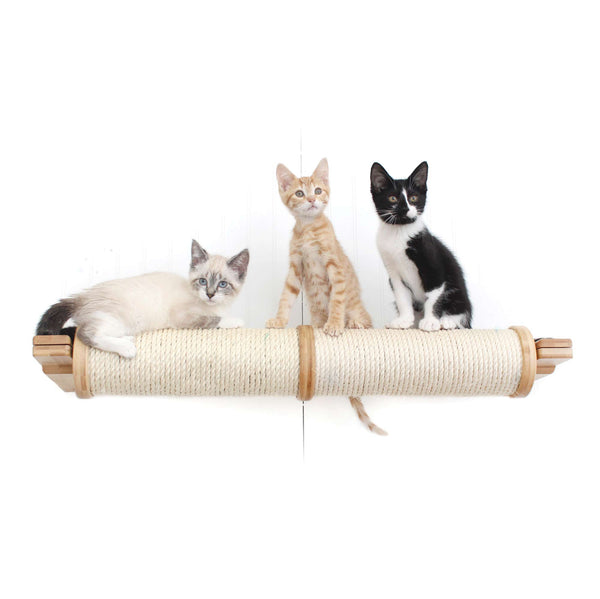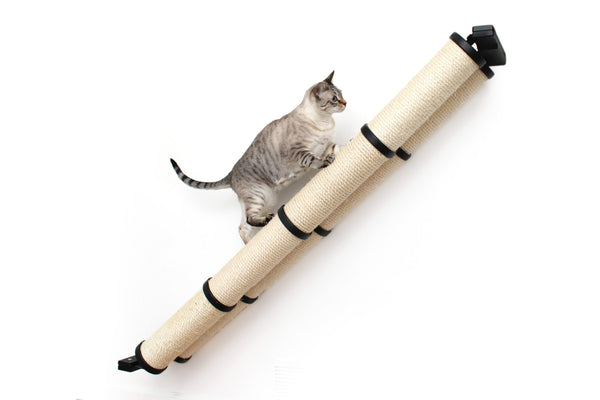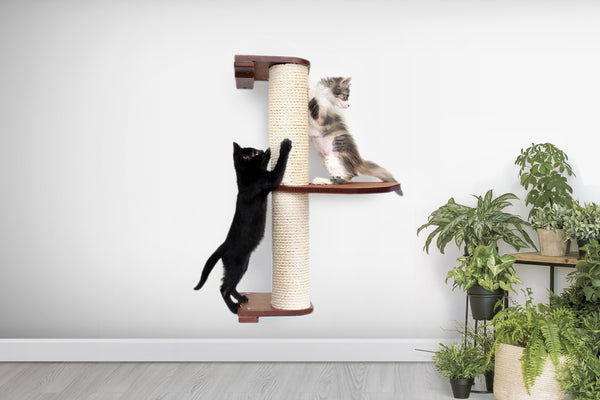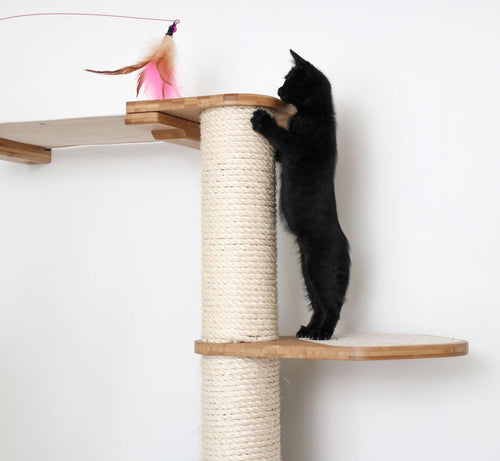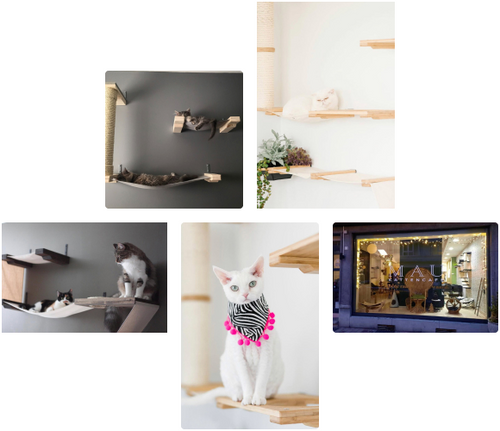The posts being wider than most of their trees was a learning curve for both of them, but after a week they became pros. They use it daily for their play 💖
Hi Lori,
Thank you for your review of our Wall Mounted Cat Climbing Pole. We're so happy to hear that your cats have quickly adapted to using it and are enjoying it every day! It's great to know that they are pros at climbing and playing on it. Thank you for choosing our product!
-Alexandria M.
Our cats love the cat climbing pole. They really like a tree-like pole to climb up. In hindsight, I probably should have ordered the version without the leaf shelves because they like to grab on and climb up and we have found the leaf shelves are just in the way where they have to maneuver around the shelves where we bought the three tier which is no problem for them to just grip and climb. I will say during installation we ran into an issue where we did not have a reliable tool to find the stud widths. We tried a magnetic tool and the usual tools that beep with a LCD screen. Both were too inaccurate for this installation where the two screws for the anchor require a level of accuracy. I finally found a tool that was very accurate where it lights up with blocks to show you the exact location and width of the stud where our studs were 5 blocks wide. I only knew this existed when I ran into the problem we had where one of my screws skidded off the sided of the stud and I did not realized it and the friction resulted in a burning smell which freaked us out if we had spared a fire in our wall. I only found this tool after we were freaked out any my g/f had a panick attack where I watched multiple youtube videos from this company where one video was a guy showing how to do custom layouts where he had a tool that had the lit up blocks. So, I was like WHOA...I NEED THAT. Once I got that, then setting up everything was easy. We used this climbing pole as the starter for them to climb to get onto the other shelves and bed we bought as shown in the picture. I will say though that the other issue we encountered as we tried to do our due diligence to plan before we buy was with the assumption each stud was 16 inches apart. Unfortunately, with inaccurate stud finding tools, we did not find out until we got this awesome stud finding tool that her studs were not 16 inches apart. So, we could not use the 18inch shelf and hammock bed we bought because those assumed 16 inch studs. So, now those are just sitting in the closet since we cannot use them. :(
but in any event, we love this climbing pool, but please make sure you get the stud finding tool that had the lit up blocks so you have an accurate assessment of your stud locations and distance they are apart. Lesson learned that I hope saves others what we ran into unfortunately where we cannot use two pieces we bought.
Thanks so much for the detailed review! I'm really glad to hear your cats are loving the climbing pole—it’s always great to hear when the products bring joy to both pets and their humans. I totally understand how tricky installation can be without the right tools. That stud finder you discovered sounds like a game changer—I appreciate you sharing that tip for others who might run into the same issue.
As for the unused pieces you mentioned, feel free to reach out to me at support@catacreations.com—I’d be happy to set up an exchange for longer or more suitable products that better fit your setup. I want to make sure you and your cats are getting the most out of your space! I am here to help! -Elexis
I have the Deluxe Fort and the crossing for my 2 Ragamuffin Kittens. The love to hang out on the wall and the furniture is beautiful and well made. My concern is that even now, at 9 months, my orange mega-floof is getting too big for the 16 in spans.
Hi Adrienne,
I’m so glad to hear your Ragamuffins are loving their wall setup—and thank you for the kind words about the furniture!
If your floofy guy is starting to outgrow the 16' spans, we offer a 32' version that’s designed specifically to work with standard 16' stud spacing. It gives larger cats a bit more room to stretch out and lounge comfortably while still being fully supported.
Feel free to reach out if you have any questions! -I’d be happy to help! -Elexis
Elexis at Cat. Creations designed the perfect wall (she was very professional, highly patient, and provided just exquisite customer service). I live in Hawaiʻi so my order (4 large boxes) had to be shipped about 5000 miles. The packaging was top-notch and absolutely nothing was broken (it would take a lot to break these products; they are super-sturdy). The directions were excellent, though I couldʻve used more detail. But Elexis and Mike (owner) have infinite patience and helped me.
Caution: Make damn sure your wall studs are strong enough to hold the weight of these products, plus happy, leaping cats. My studs are metal and I had to hire a contractor to put up a piece of plywood over the wall and the shelves, etc. were installed onto the plywood.
I did receive extra materials that I didnʻt order. I did not receive an offer for reimbursement, just a suggestion that I could buy more products to use up the extras. This actually worked for me as I had extra plywood, so my cat, Pebbles, now has 2 walls ʻo fun! Additionally, I had a LOT of hardware left over (screws, etc.) - not sure why as nothing has fallen down...yet... - but was told just to keep it. I have no use for it. Also, still have one extra piece that I was told just to keep (no offer of reimbursement).
All-in-all, SUPER HAPPY with the results and am SO GLAD I found Catastrophic Creations!!
Hi Anne,
Thank you so much for the kind words! I’m really glad to hear that you had such a great experience working with Mike and I, and that everything made it safely to Hawaiʻi. It’s awesome to hear Pebbles is enjoying her new walls of fun!
Regarding the extra materials you received: you're absolutely welcome to send them back if you’d prefer not to keep them. That said, since you're in Hawaiʻi, I want to be transparent that the return shipping would likely cost more than any refund we could offer for the parts. That’s why we suggested holding onto them or using them for future builds, but I totally understand if that’s not ideal for everyone!
Thanks again for the thoughtful review—it means a lot! -Elexis
We installed The Canyon yesterday it is just so beautiful!! It fits perfectly in our living room over our couch. Kitties were intrigued as soon as we were done. The directions are so clear. We will definitely order again.
Thank you for taking the time to leave such a lovely review of The Canyon! We're thrilled to hear that it not only looks beautiful in your living room, but also caught your kitties' attention right away. Our team works hard to ensure that our products are not only stylish, but also easy to set up with clear instructions. We appreciate your support and look forward to serving you again in the future! -Elexis
It's a lot of money! So it seems. Even though we have a decent income but it still feels like a lot of money when I was debating whether to get it or not. However, after we received the set and put it up. We feel so thankful that we took the plunge. As many have said, the quality is amazing. It's so visually pleasing that it feels like an installation art for me. However, the most important thing is that our cat loves it. He started to play on it when we were putting up the pieces and even fell asleep on one of the hemmock as the drill runs next to him. So much value. Best purchase ever.
Hi Connie,
Thank you so much for taking the time to leave such a lovely review for the Juggernaut! We are thrilled to hear that it has brought joy and pride to your household.
We understand that it may seem like a big investment, but we are so happy to hear that you are satisfied with the quality and overall design of our product. We take great pride in providing a visually pleasing and functional indoor playground for cats.
It warms our hearts to know that your cat is enjoying it as well. We hope that it continues to bring endless entertainment for your cat.
-Alexandria M.








